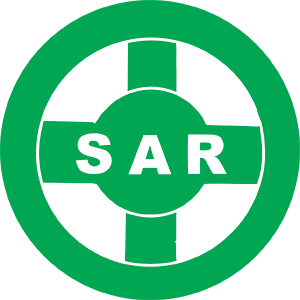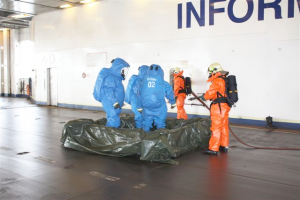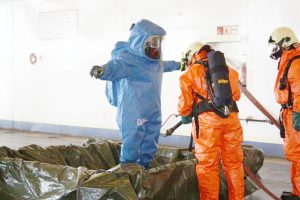Decontamination of Rescue Personnel and Decontamination of Unprotected or Injured Persons


Decontamination of Rescue Personnel

Because one can assume that rescue personnel wears suitable and intact PPE, the first concern is the sufficient supply of breathing air, especially when using gas-tight protection suits and self contained breathing apparatuses (SCBA). Therefore, the status of personal breathing air supply of every team member has to be checked when entering the decontamination station and switched to external air supply (e.g. supplementary SCBA) or respiratory filters if possible. Otherwise, the team member with the lowest remaining level of breathing air has to be the first to pass the decontamination line. In case the remaining breathing air would probably not suffice the whole decontamination process and could not be switched to external supply or filter, the team member has to pass emergency decontamination.
The decontamination process should be established as a decontamination line with different consecutive stations. On one hand this helps to assure the proper and ordered process, on the other hand every station could serve as a waiting point if several rescue teams have to be decontaminated. The line consists of following stations:
- Entry point:
Reception and briefing of the rescue teams, inspection of their breathing air level and the level of contamination.
Picture: Central Command for Maritime Emergencies, Germany - Equipment disposal:
Place to leave the rescue equipment, tools, measurement devices and so on for further decontamination (decontamination of objects). - Prewashing:
Cleaning of the surfaces of the PPE, especially the protective suit and the protective boots, from coarse dirt and contaminant. - Decontamination:
Using of warm water, brushes and mobile decontamination showers to clean the surfaces thoroughly and application of decontamination agent. - Residence time:
Time the decontamination agent needs to react with the contaminants. - Rewashing:
Thoroughly washing of the surfaces to remove the decontamination agent and any remaining contaminant. - Decontamination check:
Check of the surface, especially most often contaminated parts like front of suit, hands / palms and boots / soles, with sweep tests or monitoring devices to prove the success of the decontamination process. If any remaining contaminant is found, return to station 4 and focus on the still contaminated points. - Undressing:
Undressing of the protective clothing with the help of two assistants (one on the unclean side, one the clean side). This has to be done thoroughly to avoid spreading of contamination into the PPE. - Contamination check:
Visual check of the underwear of obvious contamination. - Medical check:
Basic check of circulation (pulse rate and blood pressure) and breathing (breathing rate) to exclude obvious health problems caused by physical stress. This includes drinking of a sufficient amount of isotonic beverages to avoid dehydration. - Documentation:
Documentation of operating time (entry and exit of hot / warm zone), levels of breathing air, health status, possible contamination and injuries. - Service point:
Provides supplementary underwear, refreshment / hygiene showers, restrooms, food and beverages, place for breaks and wating time, medical assistance, …
These stations should be considered as modular and combinable. Depending on the space available and the amount of rescue teams to decontaminate for example numbers 1 – 3, 4 – 6, 7 + 8 and 9 – 11 are usually physically combined.

The type and amount of equipment highly depends on the amount of rescue teams to decontaminate.

Decontamination of Unprotected or Injured Persons
The longer unprotected or not proper protected persons stay in the Hot Zone or in the Warm Zone, the heavier the possible harm caused by the HNS can be. Therefore, injured persons include:
- Persons in Hot Zone or Warm Zone and without proper PPE, if a contamination cannot be excluded.
- Rescue personnel with damaged, unsuitable or not resistant PPE
- Rescue personnel who undressed their PPE without adequate prior decontamination
- Rescue personnel whose skin is still suspected to be contaminated after undressing.
Basically to note: Lifesaving medical measures have priority over (coarse) decontamination. Self-protection of the medical personnel must be assured.
